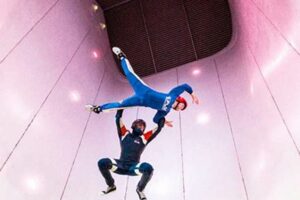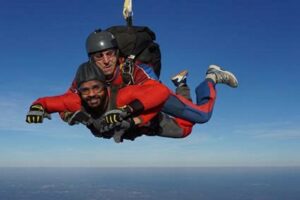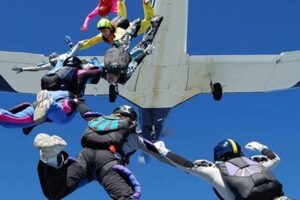Table of Contents
Average Skydiving Height: A Leap into Exhilaration and Discovery
In the realm of adrenaline-charged pursuits, skydiving stands tall, beckoning thrill-seekers to conquer their fears and embrace the freedom of flight. At the heart of this exhilarating experience lies the “average skydiving height,” a crucial factor that sets the stage for an unforgettable adventure.
Typically measured from the aircraft’s exit point to the ground, average skydiving height generally ranges from 10,000 to 13,000 feet, offering jumpers an exhilarating freefall of approximately 60 seconds before deploying their parachutes. This altitude provides ample time to savor the rush of the descent, take in breathtaking panoramic views, and create memories that last a lifetime.
The significance of average skydiving height extends beyond mere statistics. It serves as a critical safety parameter, influencing factors such as freefall time, oxygen levels, and the effectiveness of the parachute deployment. Additionally, it allows skydivers to experience varying levels of intensity, catering to different skill levels and preferences. The development of high-altitude skydiving, where jumps commence from over 20,000 feet, has further expanded the boundaries of this thrilling sport.
As we delve deeper into the world of skydiving, we’ll explore the intricacies of average skydiving height, examining its impact on safety, the factors that influence it, and the techniques employed to ensure a controlled and exhilarating descent. From understanding the physics of freefall to mastering the art of parachute deployment, our journey promises an enlightening exploration of this captivating sport.
Average Skydiving Height
In the realm of skydiving, understanding the various aspects of average skydiving height is paramount, influencing the safety, exhilaration, and overall experience of the jump.
- Altitude: The height from which the jump commences, typically ranging from 10,000 to 13,000 feet.
- Freefall Time: The duration of the descent before deploying the parachute, influenced by the altitude and jumper’s position.
- Oxygen Levels: The availability of oxygen decreases with increasing altitude, requiring supplemental oxygen at higher jump altitudes.
- Equipment: Specialized gear and equipment, including parachutes, altimeters, and oxygen systems, are essential for a safe jump.
- Safety Procedures: Rigorous protocols and procedures are in place to ensure jumper safety, from pre-jump training to emergency response plans.
- Weather Conditions: Favorable weather conditions, such as clear skies and calm winds, are crucial for a successful and enjoyable skydiving experience.
- Skill Level: The average skydiving height can vary based on the skill and experience level of the jumper, with higher altitudes reserved for more experienced individuals.
- Deployment Altitude: The altitude at which the parachute is deployed, typically around 5,000 feet, allowing sufficient time for a controlled descent.
- Landing Area: A designated landing area is chosen considering factors like wind direction, terrain, and obstacles, ensuring a safe and precise landing.
- Regulations: Skydiving operations are subject to regulations and guidelines set by governing bodies, ensuring adherence to safety standards and best practices.
These aspects are intricately connected, with each element playing a vital role in the overall skydiving experience. From the exhilarating rush of freefall to the serene beauty of the earth’s landscape from above, average skydiving height serves as a pivotal factor in shaping this thrilling and unforgettable adventure.
Altitude
Within the realm of skydiving, altitude plays a pivotal role in shaping the average skydiving height, influencing various aspects of the jump and overall experience.
The relationship between altitude and average skydiving height is one of direct proportionality. As the altitude increases, so does the average skydiving height. This is because a higher altitude provides more time for freefall, allowing jumpers to experience a longer period of exhilarating descent before deploying their parachutes. Additionally, higher altitudes offer jumpers a more expansive view of the surrounding landscape, creating a breathtaking panorama during the freefall.
The altitude from which a skydive commences is a critical component of average skydiving height. It serves as the starting point for the freefall, determining the duration of the descent and the jumper’s overall experience. For instance, a skydive commencing at 10,000 feet will typically result in a freefall of around 60 seconds, while a jump from 13,000 feet can provide up to 90 seconds of freefall. This variation in freefall time allows skydivers to tailor their jump to their desired level of excitement and intensity.
Understanding the connection between altitude and average skydiving height has practical applications in the sport. Skydiving instructors carefully consider the altitude when planning jumps for students and experienced jumpers alike. Factors such as skill level, weather conditions, and the type of skydiving being performed influence the selection of the jump altitude. Additionally, skydivers may choose to jump from different altitudes to experience varying levels of thrill and challenge.
In conclusion, altitude is an integral component of average skydiving height, directly impacting the duration of freefall, the jumper’s experience, and the overall safety of the jump. Skydiving instructors and jumpers alike must have a thorough understanding of this relationship to ensure a successful and enjoyable skydiving experience.
Freefall Time
In the realm of average skydiving height, freefall time holds a significant place, directly impacting the jumper’s experience and overall thrill of the jump. It refers to the exhilarating period of descent before deploying the parachute, influenced by factors such as altitude and the jumper’s position.
- Altitude: The Sky’s Influence
The altitude from which the skydive commences plays a crucial role in determining freefall time. Higher altitudes provide more time for freefall, allowing jumpers to relish the rush of the descent for an extended period. For instance, a jump from 13,000 feet typically offers up to 90 seconds of freefall, while a jump from 10,000 feet may provide around 60 seconds.
- Body Position: Shaping the Descent
The jumper’s body position during freefall significantly influences the duration of the descent. An arched or streamlined position, with the body held tight and facing down, minimizes air resistance, resulting in a faster descent and shorter freefall time. Conversely, a spread-eagle position, with the body and limbs extended, creates more air resistance, slowing down the descent and extending freefall time.
- Wind Conditions: A Dynamic Factor
Wind conditions also play a role in shaping freefall time. Tailwinds, or winds blowing in the same direction as the jumper’s descent, can accelerate the fall, reducing freefall time. Headwinds, on the other hand, can hinder the descent, prolonging freefall time. Skydivers must be aware of the wind conditions and adjust their b
ody position accordingly to achieve their desired freefall duration. - Parachute Deployment: Timing is Key
The timing of parachute deployment is a critical factor closely linked to freefall time. Jumpers must carefully monitor their altitude and deploy their parachutes at a predetermined height, typically around 5,000 feet, to ensure a safe and controlled descent. Premature deployment may result in a shorter freefall time, while delayed deployment could lead to a potentially dangerous low-altitude parachute opening.
Freefall time is an integral aspect of average skydiving height, offering jumpers a period of exhilarating descent before transitioning to a controlled parachute landing. Understanding the factors that influence freefall time allows skydivers to tailor their jump to their desired level of excitement and challenge, while ensuring safety remains paramount.
Oxygen Levels
In the realm of skydiving, understanding the connection between oxygen levels and average skydiving height is paramount for ensuring the safety and well-being of jumpers. As altitude increases, the availability of oxygen in the atmosphere decreases, necessitating careful consideration of oxygen levels when determining average skydiving height.
The relationship between oxygen levels and average skydiving height is one of cause and effect. As skydivers ascend to higher altitudes, the partial pressure of oxygen in the atmosphere decreases, leading to a reduction in the amount of oxygen available for respiration. This decrease in oxygen levels can cause hypoxia, a condition characterized by inadequate oxygen supply to the body’s tissues, which can impair consciousness, judgment, and coordination. To mitigate the risk of hypoxia, skydivers must carefully manage their altitude and use supplemental oxygen at higher jump altitudes.
Real-life examples of the importance of oxygen levels in skydiving are evident in the practices and procedures followed by skydiving organizations and instructors. Skydivers are required to use oxygen systems, such as oxygen tanks and masks, when jumping from altitudes above a certain threshold, typically around 10,000 feet. These oxygen systems provide a controlled and reliable supply of oxygen, ensuring that jumpers maintain adequate oxygen levels throughout the jump.
The practical significance of understanding the connection between oxygen levels and average skydiving height lies in its direct impact on safety. By carefully managing altitude and using supplemental oxygen when necessary, skydivers can minimize the risk of hypoxia and its associated dangers. This understanding also enables skydiving instructors to tailor jump profiles to the experience level and physical condition of each jumper, ensuring a safe and enjoyable skydiving experience for all.
In conclusion, the connection between oxygen levels and average skydiving height is a critical consideration for ensuring the safety of skydivers. The decrease in oxygen availability with increasing altitude necessitates the use of supplemental oxygen at higher jump altitudes. Skydiving organizations and instructors have established strict protocols and procedures to manage oxygen levels effectively, minimizing the risk of hypoxia and ensuring a safe and enjoyable skydiving experience.
Equipment
In the realm of skydiving, the connection between specialized equipment and average skydiving height is a critical one, with each element influencing the other in a cause-and-effect relationship.
The specialized gear and equipment used in skydiving play a vital role in ensuring the safety and success of a jump. Parachutes, altimeters, and oxygen systems are essential components of a skydiver’s arsenal, each contributing to a safe and controlled descent from the aircraft to the ground.
The type of parachute used, for instance, can impact the average skydiving height. Larger parachutes provide more drag and stability, making them suitable for beginners or jumps from higher altitudes. Smaller, more advanced parachutes offer increased maneuverability but require more skill to operate, often used by experienced skydivers at lower altitudes.
Altimeters, which measure altitude, are crucial for skydivers to monitor their descent and determine the appropriate time to deploy their parachutes. Oxygen systems, particularly at higher altitudes, provide supplemental oxygen to combat the effects of reduced atmospheric oxygen levels, ensuring the skydiver’s safety and preventing hypoxia.
Real-life examples of this connection abound. Skydiving organizations and instructors strictly enforce the use of appropriate equipment based on jump altitude and skill level. Rigorous maintenance and inspection procedures are in place to ensure the reliability and functionality of parachutes and other gear.
Understanding this connection has practical applications in skydiving training and operations. Skydivers receive comprehensive training on the proper use and maintenance of their equipment, emphasizing the importance of regular inspections and adherence to safety protocols. This knowledge empowers skydivers to make informed decisions regarding equipment selection and jump parameters, contributing to a safer and more enjoyable skydiving experience.
In summary, the specialized gear and equipment used in skydiving are integral to the concept of average skydiving height, influencing factors such as safety, performance, and enjoyment. Understanding this connection and adhering to strict safety protocols are paramount for skydivers of all skill levels, ensuring a successful and memorable skydiving experience.
Safety Procedures
Within the realm of average skydiving height, safety procedures stand as a cornerstone, encompassing a comprehensive framework of protocols and measures designed to safeguard jumpers throughout their skydiving experience.
- Pre-Jump Training: Laying the Foundation for Safety
Prior to embarking on a skydiving adventure, jumpers undergo rigorous training conducted by experienced instructors. This training covers essential aspects such as equipment familiarization, proper body position, emergency procedures, and safe landing techniques, equipping jumpers with the knowledge and skills necessary for a safe and controlled jump.
- Equipment Inspection: Ensuring Reliability
Before each jump, skydiving equipment undergoes meticulous inspection and maintenance. Parachutes, altimeters, oxygen systems, and other gear are thoroughly checked to ensure they are in einwandfrei working order, minimizing the risk of equipment failure and enhancing jumper safety.
- Emergency Response Plans: Preparing for the Unexpected
Skydiving operations have comprehensive emergency response plans in place to address potential incidents or accidents. These plans involve trained personnel, specialized equipment, and established protocols for responding to various emergencies, such as midair collisions, equipment malfunctions, or adverse weather conditions.
- Strict Altitude and Weather Guidelines: Mitigating Risks
To ensure safe jumps, skydiving organizations adhere to strict altitude and weather guidelines. Jump altitudes are carefully selected based on factors such as jumper experience, weather conditions, and equipment capabilities. Additionally, weather forecasts are closely monitored, and jumps are canceled or postponed in the event of unfavorable conditions, minimizing the risks associated with skydiving.
These safety procedures are intrinsically connected to average skydiving height, as they play a critical role in managing the inherent risks associated with jumping from higher altitudes. By implementing rigorous protocols, conducting thorough training, and maintaining strict guidelines, skydiving operations strive to mitigate risks and create a safe environment for jumpers to experience the exhilaration of skydiving.
Weather C
onditions
In the realm of skydiving, weather conditions hold a pivotal role in determining the safety, feasibility, and overall enjoyment of a jump. Favorable weather conditions, characterized by clear skies, calm winds, and good visibility, are paramount for ensuring a successful and enjoyable skydiving experience, particularly when considering average skydiving height.
- Clear Skies: Enhancing Visibility and Safety
Unobstructed visibility is essential for skydivers to navigate safely during freefall and accurately judge their landing zone. Clear skies provide optimal conditions for jumpers to maintain visual contact with their surroundings, fellow jumpers, and the ground, reducing the risk of collisions and ensuring a controlled descent.
- Calm Winds: Ensuring Stability and Control
Strong winds can significantly impact the trajectory and stability of a skydiver during freefall and landing. Calm winds provide a stable environment for jumpers to maintain control and execute maneuvers safely. Moreover, consistent wind speeds minimize the risk of sudden changes in wind direction, which can lead to unpredictable and potentially dangerous situations.
- Good Visibility: Facilitating Communication and Navigation
Good visibility is crucial for effective communication between skydivers and ground personnel, as well as for jumpers to navigate accurately towards their intended landing zone. Clear visibility allows skydivers to maintain visual contact with each other, perform formation skydives safely, and make informed decisions during the jump, enhancing the overall safety and enjoyment of the experience.
- Stable Atmospheric Conditions: Minimizing Risks
Stable atmospheric conditions, characterized by minimal turbulence and consistent air density, are essential for a safe and controlled skydive. Unstable atmospheric conditions, such as sudden changes in temperature or wind speed, can create unpredictable and hazardous conditions, increasing the risk of accidents. Stable atmospheric conditions provide a predictable environment for skydivers to operate safely, particularly at higher altitudes where changes in atmospheric conditions can be more pronounced.
Understanding the significance of favorable weather conditions in relation to average skydiving height is crucial for ensuring a successful and enjoyable skydiving experience. By carefully monitoring weather forecasts, adhering to safety guidelines, and making informed decisions, skydivers and jump operators can mitigate the risks associated with adverse weather conditions and create a safe and enjoyable environment for skydivers of all skill levels.
Skill Level
In the context of average skydiving height, skill level plays a critical role in safety, thrill, and overall enjoyment of the jump.
- Skill Level and Jump Safety
- Skill Level and Thrill-seeking
- Skill Level and Personal Accomplishment
- Skill Level and Social Status
The relationship between skill level and average skydiving height is closely correlated. As skills advance, individuals are better prepared to handle the inherent challenges and complexities associated with higher jumps. They posses the experience, knowledge, and composure to manage the increased altitude, allowing for a safer and more thrilling jump. As skills increase, individuals have greater control over their bodies and parachutes, allowing them to perform intricate maneuvers and controlled freefall patterns. This mastery and skill level lead to a sense of personal accomplishment and a unique social status among their peers.
Deployment Altitude
Deployment altitude, typically around 5,000 feet, plays a pivotal role in shaping the overall skydiving experience, influencing safety, thrill, and technique.
The relationship between deployment altitude and average skydiving height is one of cause and effect. The deployment altitude directly impacts the duration of freefall, which is a key component of the skydiving experience. Higher deployment altitudes result in longer freefall times, providing skydivers with an exhilarating and extended period of descent before deploying their parachutes.
Real-life examples underscore the importance of deployment altitude in skydiving. For instance, skydivers aiming for a longer freefall experience might choose to jump from higher altitudes and deploy their parachutes closer to the ground, allowing for a more extended period of freefall. Conversely, those seeking a shorter freefall may opt for lower deployment altitudes, ensuring a quicker transition to a controlled descent.
Understanding the connection between deployment altitude and average skydiving height has practical applications in skydiving training and operations. Skydiving instructors emphasize the importance of selecting an appropriate deployment altitude based on factors such as skill level, weather conditions, and the desired skydiving experience. This understanding empowers skydivers to make informed decisions, ensuring a safe and enjoyable jump.
In summary, deployment altitude is a critical component of average skydiving height, significantly impacting the duration of freefall and the overall skydiving experience. Skydivers must carefully consider deployment altitude in conjunction with other factors to ensure a safe and exhilarating jump.
Landing Area
In the realm of skydiving, the selection of an appropriate landing area holds paramount importance, directly influencing the safety and success of a jump. Landing area selection is intricately linked to average skydiving height, as it determines the jumper’s descent trajectory, freefall time, and overall landing experience.
- Precision and Control: The designated landing area serves as a precise target for the skydiver, guiding their descent and enabling a controlled landing. Faktoren such as wind direction and terrain are carefully considered to ensure a smooth and accurate touchdown.
- Safety Considerations: The landing area is meticulously chosen to minimize potential hazards. Obstacles like power lines, trees, and buildings are identified and avoided, creating a safe zone for the skydiver to land.
- Wind Conditions: Wind direction and speed play a crucial role in landing area selection. Favorable wind conditions allow for a controlled descent and precise landing, while strong or unpredictable winds may necessitate a change in landing location.
- Terrain and Obstacles: The terrain and obstacles in the landing area are thoroughly assessed to ensure a safe landing. Factors such as the slope, vegetation, and any potential hazards are taken into account to minimize the risk of injury.
Understanding the significance of landing area selection in relation to average skydiving height is essential for ensuring a safe and enjoyable skydiving experience. Skydivers and instructors work together to carefully assess and select landing areas that align with the specific jump profile, weather conditions, and skill level of the jumper, ensuring a successful and memorable skydiving adventure.
Regulations
Regulations and guidelines governing skydiving operations play a crucial role in maintaining safety standards and best practices, directly impacting the concept of average skydiving height.
The connection between regulations and average skydiving height can be understood through cause and effect. Stringent regulations and guidelines set forth by governing bodies establish parameters for jump altitudes, equipment requirements, training standards, and operational procedures. These regulations ensure that skydiving is conducted in a controlled and safe manner, reducing the inherent risks associated with the activity. As a result, skydivers c
an participate in the sport with a greater degree of confidence, knowing that their safety is prioritized.
Real-life examples abound where regulations have had a tangible impact on average skydiving height. In the United States, the Federal Aviation Administration (FAA) regulates skydiving operations, including jump altitudes and equipment requirements. This regulatory framework has contributed to a significant reduction in skydiving accidents and fatalities over the years. Similarly, in many countries, national aviation authorities enforce strict regulations governing skydiving operations, ensuring adherence to safety protocols and promoting a responsible approach to the sport.
The practical significance of understanding the connection between regulations and average skydiving height lies in its ability to inform decision-making and enhance safety. Skydiving instructors and operators rely on these regulations to design jump profiles, select appropriate equipment, and conduct training programs. Moreover, regulations provide a benchmark for skydivers to assess the safety and credibility of skydiving companies, empowering them to make informed choices about their participation in the sport.
In conclusion, regulations and guidelines governing skydiving operations are inextricably linked to the concept of average skydiving height, underscoring the importance of safety standards and best practices. These regulations have a direct impact on jump altitudes, equipment requirements, training standards, and operational procedures, contributing to a safer and more enjoyable skydiving experience. Understanding this connection allows skydivers, instructors, and operators to make informed decisions, promoting a responsible approach to the sport and mitigating potential risks.
Frequently Asked Questions
This section aims to address common queries and clarify aspects related to “average skydiving height,” providing concise and informative answers to frequently asked questions.
Question 1: What is the typical range for average skydiving height?
Typically, average skydiving height falls between 10,000 and 13,000 feet above ground level, offering a balance between exhilarating freefall time and manageable descent.
Question 2: How does altitude impact the skydiving experience?
Altitude directly influences the duration of freefall, with higher altitudes providing longer freefall times, allowing for more thrilling and extended descent experiences.
Question 3: Are there safety considerations associated with average skydiving height?
Safety is paramount in skydiving, and average skydiving height is carefully regulated to ensure jumper safety. Factors like oxygen levels, equipment capabilities, and weather conditions are closely monitored to minimize risks.
Question 4: How do skill level and experience influence average skydiving height?
Skill level plays a role in determining average skydiving height. Experienced skydivers may opt for higher jump altitudes to enhance the thrill and challenge, while beginners typically start with lower altitudes to ensure a controlled and manageable jump.
Question 5: What is the significance of deployment altitude in skydiving?
Deployment altitude, typically around 5,000 feet, marks the point at which the parachute is deployed. It directly impacts the duration of freefall and the overall skydiving experience, allowing skydivers to tailor their jump to their desired level of excitement.
Question 6: How do weather conditions affect average skydiving height?
Favorable weather conditions, such as clear skies and calm winds, are essential for safe and enjoyable skydiving. Adverse weather, including strong winds or low visibility, can the average skydiving height and may lead to adjustments or even cancellation of jumps.
In summary, understanding “average skydiving height” involves considering factors such as altitude, safety, skill level, deployment altitude, and weather conditions. These elements collectively shape the skydiving experience, ensuring a safe and exhilarating adventure for participants.
Moving forward, the next section will delve deeper into the intricacies of skydiving equipment, exploring the specialized gear and systems that enable skydivers to navigate the skies safely and confidently.
Skydiving Tips for an Unforgettable Experience
The TIPS section provides invaluable advice and practical tips to enhance your skydiving experience, ensuring safety, enjoyment, and lasting memories.
Tip 1: Choose a Reputable Skydiving Company:
Research and select a skydiving company with an excellent safety record, experienced instructors, and a commitment to providing a thrilling yet secure jump.Tip 2: Listen Attentively During Training:
Pay close attention to the pre-jump training provided by your instructor. This training covers essential aspects like body position, parachute deployment, and emergency procedures.Tip 3: Communicate Your Concerns and Expectations:
Openly communicate any concerns or specific expectations you have with your instructor. They are there to guide you and ensure you have a positive experience.Tip 4: Dress Appropriately:
Wear comfortable clothing that allows for freedom of movement and protects you from the cold temperatures at higher altitudes. Avoid loose clothing or jewelry that could interfere with your jump.Tip 5: Breathe Deeply and Relax:
Deep breathing and relaxation techniques can help manage anxiety and keep you calm before and during the jump. Trust your instructor and the equipment they provide.Tip 6: Enjoy the Freefall and Take In the Scenery:
Once you’re in freefall, embrace the exhilarating rush and the breathtaking views. Let go of any fears and immerse yourself in the moment.Tip 7: Deploy Your Parachute at the Right Altitude:
Follow your instructor’s guidance and deploy your parachute at the designated altitude. This ensures a safe and controlled descent, allowing you to enjoy the canopy ride.Tip 8: Practice Proper Landing Techniques:
Pay attention to the landing instructions provided during training. Maintain a stable body position and follow the recommended landing procedures to ensure a smooth and safe touchdown.
By following these tips, you can maximize your skydiving experience, ensuring a safe, enjoyable, and memorable adventure. These tips lay the foundation for the concluding section, which will delve into the captivating stories and experiences of individuals who have taken the leap and embraced the thrill of skydiving.
Conclusion
Our exploration of “average skydiving height” has illuminated its multifaceted nature, encompassing considerations of safety, exhilaration, and technique. Key points that emerge from this exploration include the following:
- Average skydiving height, typically between 10,000 and 13,000 feet, provides a balance between thrilling freefall time and manageable descent.
- Factors such as skill level, weather conditions, and deployment altitude influence the average skydiving height, tailoring the experience to individual preferences and safety requirements.
- Rigorous regulations and safety procedures govern skydiving operations, ensuring that jumps are conducted in a controlled and responsible manner.
The captivating stories and experiences shared by skydivers underscore the transformative power of this exhilarating sport. Whether seeking an adrenaline rush, overcoming fears, or simply embracing the beauty of the world from a unique perspective, skydiving offers an unforgettable adventure.
As we reflect on the significance of average skydiving height, we recognize its role in shaping the overall skydiving experience. It is a testament to the care
ful planning and execution that underpin this thrilling activity, ensuring that participants can safely enjoy the freedom and exhilaration of soaring through the skies.







